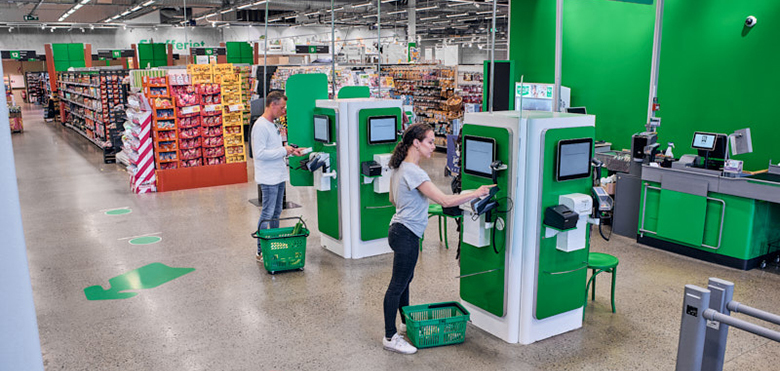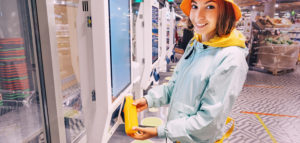From autonomous robots to real-time personalization – the top retail trends for 2023 and beyond
Ecommerce and online shopping have become the bedrocks of the retail industry and we’re now in the middle of a third retail shift, characterized by automation, social engagement and hyper personalization. According to a new report titled ‘Radical retail 2030’, shoppers and communities are increasingly becoming co-creators, and the physical world is merging with the digital – so-called ‘phygital’ experiences – which will manifest in virtual ‘metaverses’.
At the same time there is a desire for more sustainable retail, enabled by large-scale deployments of digital technology. As we look toward the remainder of 2023, here are the top retail trends which will dominate the industry now and in future
Real-time personalization connects you to your customers’ needs
Retailers are improving their capacity to give recommendations to customers in real-time, based on current shopping activity and customer profiles. AI-powered customer interaction is the next wave in connecting with shoppers to improve personalization and ultimately boost sales.
As a leader in the field of data analysis, Google is already implementing this type of technology. AI-shopping recommendations are as finetuned and powerful as you would expect. These are based on two factors: 1) the customer’s current online and shopping activity, i.e., what products they have visited, clicked on and put in their cart recently, and 2) overall customer information such as the purchase and return history. Armed with this information, a sophisticated customer profile can be built which aligns perfectly with preferences to help shorten the online shopping journey and deepen relationships.
But what happens when we try to replicate this within a physical store? It’s much more difficult to know what shoppers place in and remove from baskets or if they even entered the store. Data collection in physical spaces is increasingly becoming a key trend for retailers, where network cameras equipped with analytics are used to understand customer behavior while in store. For example, information on discarded items, how long shoppers linger in a certain area and which products ultimately make it to the checkout area can inform future decisions about ‘friction-free’ store layouts and stock displays.
Speaking of inventory management, there is a real benefit to keeping shelves stocked with in-demand products. According to research from SymphonyIRI Group, out-of-stock levels for FMCG products across Europe average at 8.3% and cost the industry at least €4 billion (£3.5bn) every year. Fortunately, AI can assist you in monitoring stock levels in real time. In fact, Google Cloud’s new shelf checking AI technology utilizes the company’s database and sophisticated algorithms along with high-performance network cameras to quickly recognize billions of products and ensure in-store shelves are stocked.
Hybrid stores enable customer access around the clock
Despite the prevalence of ecommerce, physical stores are still an important part of the shopping experience. According to research by Salesforce, customers value visiting physical stores because it allows them to touch and feel products, make immediate purchases, avoid shipping fees and enjoy the shopping experience. Moreover, the shop is an effective logistical solution to distributing goods.
Traditionally the store’s opening hours have limited customer access, but there has been a shift in the industry to completely or partially autonomous operations. These stores often have unlimited, secure opening hours which are enabled by advanced technology such as integrated video, analytics, and audio solutions. Not only does this improve the convenience for the customer by complementing their schedules, but also supports labor challenges such as staff shortages.
As would be expected with an autonomous store, there are concerns around the safety and security of shoppers and shoplifting. By implementing security solutions which can monitor for loitering, detect sounds of aggression or intrusion you can respond or deescalate incidents quickly to maintain a safe environment.
Logistics goes autonomous
One of the most troublesome and expensive parts of the customer journey is the product delivery. In fact, last mile delivery can account for 53% of the total shipping costs. Delayed or extended delivery times can negatively impact your customer’s shopping experience and add frustration. As a result, more logistics professionals are investing in autonomous logistics, which refers to a system that can handle logistics within the supply chain without, or with minimal, human involvement. This would mean that deliveries could happen over longer timeframes – thereby increasing consumer convenience – and not be limited by staff shortages or working hours.
Looking further up the chain, automation is increasingly being used in warehouses and distribution centers. From access control using Radio Frequency Identification (RFID) readers to network cameras which automatically track packages to ensure these are packed and shipped correctly, technology is becoming a critical factor to improve efficiencies and delivery outcomes.
Sustainability and transparency drive consumer decisions
Even though shoppers are still spending, there has been a change in behavior to reflect wider societal issues. Economic uncertainty is driving customers to make more considered decisions around their spending, with many choosing to explore rental, repair, peer-to-peer exchange and secondhand marketplaces. Beyond this, customers are keen to understand production costs and where and how materials are sourced. This thoughtfulness provides an opportunity for you to use data to increase transparency.
Customers not only want to know information about the supply chain to ensure that sustainable values are at the core of your network, but they also want to be reassured that their data is being treated ethically and securely. By being open about your practices around choosing suppliers and data privacy and security, this will help deepen relationships.
Technology is at the heart of retail’s evolution
We’re currently at another inflection point for the retail industry. There’s more automaton, robotization and AI-powered solutions implemented to affect different parts of the customer journey. Many of the changes discussed focus on improving the in-store experience, anticipating customer needs, reducing friction and loss prevention. This can only be achieved by implementing integrated technology in stores to provide full visibility and useful data to inform future decisions.
The most innovative retailers who are looking to move the needle are already making serious investments. In fact, according to research from analyst firm IHL Group, from 2020-2022 retail saw a 25% increase in the amount of revenue spent on technology purchases. That has only continued to grow with 2023 adding another 4.3% growth of IT Spend.
The challenge will be choosing the right technology to support your customers’ needs. To do this, you will need to do a comprehensive and honest assessment of your operations to see where improvements can be made. That way you can implement the types of changes which will build customer loyalty and advocacy in a competitive landscape.
To learn more about Axis’ solutions for retailer, click here:


